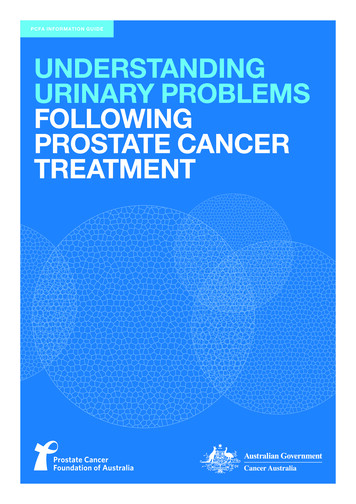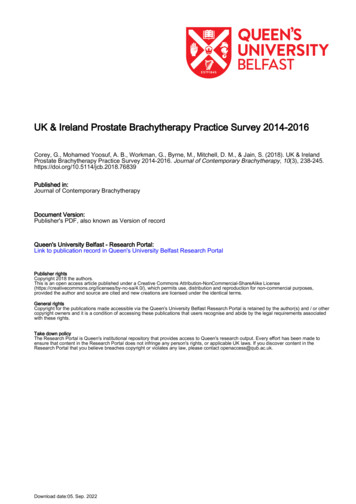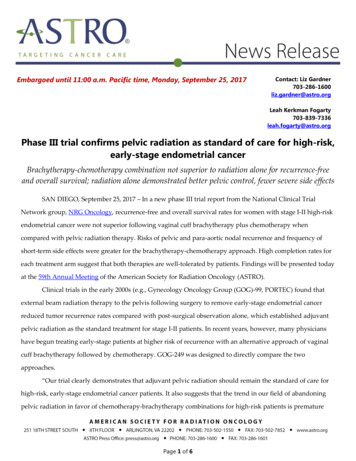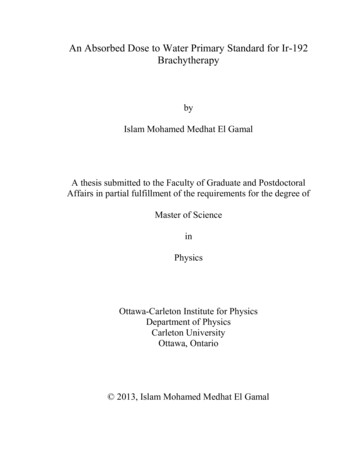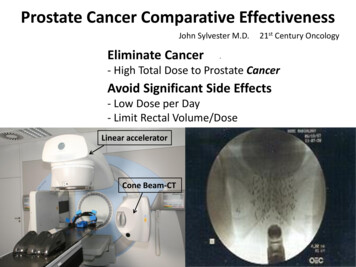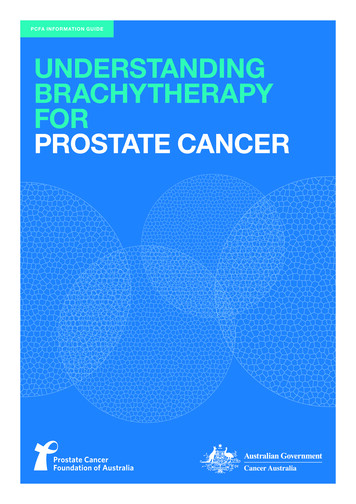
Transcription
PCFA INFORMATION GUIDEUNDERSTANDINGBRACHYTHERAPYFORPROSTATE CANCER
This book is for men who have made a decision to have a specifictreatment or have already received treatment for prostatecancer. It contains information about important issues to helpmen who need to know about brachytherapy treatment andprostate cancer.PCFA provides a range of resources to support men, partnersand their families with prostate cancer. For further information,please see www.pcfa.org.au.NOTE TO READERACKNOWLEDGEMENTSThis resource was developed by a multidisciplinary Expert AdvisoryGroup.PCFA gratefully acknowledges the input, advice and guidance ofthe men with prostate cancer and health professionals who helpedin the development of this booklet by offering their time to review itscontent.— Associate Professor Nick Brook (Urologist)— Professor Suzanne Chambers (Psychologist)Because what is known about prostate cancer and its treatmentis constantly changing and being updated, your treating healthprofessionals will give you information that is specific to your uniqueneeds and situation.— Marie-Claire Cheron – Sauer (PCFA)If you would like further information please contact PCFA(telephone: 61 2 9438 7000 or freecall 1800 22 00 99email: enquiries@pcfa.org.au, website: www.pcfa.org.au).— Mr Nigel Cook (Consumer)DISCLAIMER— Ms Susan Hanson (Cancer Australia)PCFA develops materials based on the best available evidence andadvice from recognised experts; however, it cannot guarantee andassumes no legal responsibility for the currency or completeness ofthe information.— A ssociate Professor Pauline Chiarelli (Physiotherapist)— Associate Professor Eric Chung (Urologist)— Professor Jon Emery (Primary care physician)— Helen Falconer (PCFA)— Dr Amy Hayden (Radiation Oncologist)— Mr Ian Henderson (Prostate Cancer Specialist Nurse)— A ssociate Professor Michael Izard (Radiation Oncologist)— A ssociate Professor Michael Jefford (Medical Oncologist)PERIODIC UPDATES— Ms Jocelyn Klug (Sexual rehabilitation specialist)It is planned that PCFA will review this booklet after a period of, butnot exceeding, four years.— Marieke Koets (PCFA)Copyright Prostate Cancer Foundation of Australia 2014— Dr David Malouf (Urologist)This work is copyright. Apart from any use as permitted under theCopyright Act 1968 no part may be reproduced by any processwithout prior written permission from the Prostate Cancer Foundationof Australia. Requests and enquiries concerning reproduction andrights should be addressed to the Chief Executive Officer, ProstateCancer Foundation of Australia, PO Box 499, St Leonards, NSW1590, Australia. Website: www.pcfa.org.auEmail: enquiries@pcfa.org.au— Dr Vivienne Milch (Cancer Australia)ISBN 978-0-9941841-8-4— Mr John Stubbs (CanSpeak)Supporting men with prostate cancer through evidence-basedresources and support is a Cancer Australia initiative, funded by theAustralian Government.— Ms Julie Sykes (PCFA)— Associate Professor Anthony Lowe (PCFA)— Caroline Nehill (Cancer Australia)— Professor Ian Olver AM (Cancer Council Australia)— Ms Carolyn Russell (Radiation Oncology Nurse Specialist)— Mr David Sandoe OAM (PCFA/consumer)— Ms Jennifer Siemsen (Prostate Cancer Specialist Nurse)— Mr Alex Sloss (Consumer)— Dr Sandra Turner (Radiation Oncologist)— Ms Glenice Wilson (Continence Advisor)— Dr Tim Wong (PCFA)— Associate Professor Henry Woo (Urologist)Editor:Ms Helen SignyMedical Illustration:Mr Marcus CremonesePhotography:Mr Gavin Jowitt
Contents1Introduction22What is the prostate?33What is prostate cancer?34What is brachytherapy – an overview?45Who is suitable for brachytherapy?56Low dose rate (LDR) brachytherapy (seed implants)67High dose rate (HDR) brachytherapy108Side effects from LDR and HDR and how to manage149Monitoring your health after either type of brachytherapy treatment1710 Your emotional wellbeing1711 Your healthcare team1812 Where to go to get support and assistance1913 Glossary21Welcome. We hope youfind the following contentinformative and clear.
UNDERSTANDING BRACHYTHERAPY FOR PROSTATE CANCER1IntroductionThis booklet is for men who have made a decision to havebrachytherapy treatment or have already received brachytherapytreatment for prostate cancer. It is also designed for men whoare in the process of deciding on their treatment option. It couldbe helpful for significant people in your life, such as your partner,family and friends, to read this booklet.As the diagram ‘Your cancer journey’ shows, it can be usefulto think of the journey in stages that may include detection,diagnosis, treatment, follow-up care and survivorship. For some,it may include end of life care. Take each stage as it comes soyou can break down what feels like an overwhelming situationinto smaller, more manageable steps.Your cancer journeyAfter being diagnosed with prostate cancer, it’s common for youto see a number of health professionals with different expertisewho work together as a multidisciplinary team (also known asa healthcare team). Best practice treatment and supportive carefor people with cancer involves a multidisciplinary team to whicheach team member brings different skills that are important inmanaging care and in making decisions around your individualneeds. The team includes health professionals who are involvedin diagnosing your cancer, treating your cancer, managingsymptoms and side effects, and assisting you with your feelingsor concerns during your cancer experience.For some men, the impact of treatment may be minimal orquickly resolved. For others, this impact can be more difficult,requiring further support and help. The aim of this booklet is toprovide you with information that you can then use as a guideto further discussions with your doctor and healthcare teamabout your situation. Being informed enables you to participatein decisions about your care and leads to improved experiencesand better care.The cancer journey is your personal experience of cancer.It’s not the same for everybody, even with the same type ofcancer. Depending on your stage of prostate cancer and otherunderlying conditions, your experience may be quite different tosomeone else’s.YOUR CANCER JOURNEYMulti-disciplinary Care TeamSurvivorshipDetectionDiagnosisTreatmentand managingside effectsFollow-upcareEnd of life careSupportive Care2
UNDERSTANDING BRACHYTHERAPY FOR PROSTATE CANCER23What is the prostate?What is prostate cancer?The prostate is a small gland located below the bladder and infront of the rectum in men. It surrounds the urethra, the passagein the penis through which urine and semen pass.Prostate cancer occurs when abnormal cells develop in theprostate. These cells have the potential to continue to multiply,and possibly spread beyond the prostate.The prostate gland is part of the reproductive system (seediagram). It produces most of the fluid that makes up semen,which enriches and protects sperm. The prostate needs themale hormone testosterone to grow and develop. Testosterone ismade by the testicles.The prostate is often described as the size of a walnut and itis normal for it to grow as men age. Sometimes this can causeproblems, such as difficulty with urinating. It is important toremember that these problems may not be symptoms of cancer.THE MALE REPRODUCTIVE SYSTEMProstate glandSeminalvesicleVas deferensUrinary otumPenis3
UNDERSTANDING BRACHYTHERAPY FOR PROSTATE CANCER4What is brachytherapy –an overview?Brachytherapy is a type of radiation therapy (radiotherapy) inwhich a radioactive source is placed directly into or next to anorgan or tissue with a cancer in it. In the case of prostate cancer,one of two main types of brachytherapy may be an option –either low dose rate (LDR) or a high dose rate (HDR). ‘Dose rate’refers to the speed at which the dose is delivered, not the actualdose itself. Brachytherapy may not be available in all hospitalsand is not suitable for all prostate cancers.MORE INFORMATIONBrachytherapy can cause side effects such as stinging and frequentand/or difficult urination. There is no reason not to have sex soon afterbrachytherapy but you may not feel like it for the first few weeks. You maybe advised to take certain precautions initially like wearing a condomwhen having sexual intercourse.LDR brachytherapy or ‘seed’ implant involves the insertion ofpermanent radioactive sources directly into the prostate. Thesesources or ‘seeds’ give off a localised radiation to the entireprostate with the aim of destroying the cancer cells. The radiationis limited to the prostate and only a few millimetres around it.LDR brachytherapy is generally a treatment for men with prostatecancer which is completely contained within the prostate gland.Placement of ‘seeds’ requires a procedure under anaestheticthat typically takes an hour or two. You may be able to have thetreatment as a ‘day-only patient’ or be booked for an overnightstay.HDR brachytherapy also involves radioactive material beingplaced directly into the prostate but, unlike LDR seeds, theplacement of the material is temporary and for shorter periods –usually for a day or two at a time. The procedure takes place at ahospital but may require a longer stay than LDR brachytherapy. Itis often given in conjunction with external beam radiation therapy(EBRT) for locally advanced disease.4
UNDERSTANDING BRACHYTHERAPY FOR PROSTATE CANCER5Who is suitable for brachytherapy?The type of brachytherapy you may be offered mainly dependson the stage of your prostate cancer as well as other featuressuch as the amount of cancer, the Gleason score and the PSA.It may also depend on a man’s suitability for an anaesthetic, thesize and shape of the prostate and the degree of any urinarysymptoms currently experienced. Further details are given belowunder the specific types of brachytherapy.High dose rate brachytherapy is generally a treatment for menwith locally advanced disease and/or when the cancer has higherGleason scores and/or volume.Locally advanced prostate cancer is when the cancer has spreadto the area just outside the prostate and may include seminalvesicles (the glands that produce semen) or other surroundingorgans such as the bladder or rectum.Low dose rate brachytherapy is generally a treatment for menwith localised disease.LOCALLY ADVANCED PROSTATE CANCERWhen the cancer is found only in the prostate gland, this isknown as localised prostate cancer or early prostate cancer.LOCALISED PROSTATE TumourProstateFor some men, neither type of brachytherapy is suitable. Oftenthere are effective alternate options for treatment that may beequally suitable for your situation. You are encouraged to discussyour own circumstances with your treating doctor.ProstateTumourThis booklet discusses both types of brachytherapy. It isrecommended you read the section that relates to the typeof brachytherapy you are receiving as the treatments differin their delivery.5
UNDERSTANDING BRACHYTHERAPY FOR PROSTATE CANCER6Low dose rate (LDR)brachytherapy (seed implants)This section is intended for men having lowdose rate (seed) brachytherapy. If you are havinghigh dose rate brachytherapy, please refer to thenext section.? Listed below are some questions you may want to ask yourradiation oncologist or members of your healthcare teamabout prostate cancer brachytherapy.WHO CAN HAVE LOW DOSE RATE BRACHYTHERAPY?LDR brachytherapy is generally a treatment option for men withlocalised prostate cancer. It is used to treat localised prostatecancer with the intent of curing the cancer. It is generally used intreating cancer in men who meet the following criteria:— What does brachytherapy involve?—W hat are the benefits and how likely are they?— Disease stage – localised prostate cancer—W hat are the possible side effects and how likely are theyto occur?— Gleason score equal to or less than 7— Initial PSA level lower than 10ng/ml—H ow will brachytherapy affect my quality of life?— Less than 50% of biopsy cores involved with cancer— A prostate volume of less than 50cm3—H ow will brachytherapy affect my sexual function or sexlife?— Minimal urinary symptoms—W ill brachytherapy make me incontinent?— No previous prostate surgery.—W hat are the costs involved with brachytherapy?WHAT IS LOW DOSE RATE BRACHYTHERAPY?—H ow may brachytherapy affect other health conditionsI may have?This treatment is given by implanting permanent radioactivesources or ‘seeds’ directly into the prostate. The seeds giveoff concentrated amounts of radiation to the prostate with theaim of killing the cancer cells. Because the radiation is limitedto the prostate and only a few millimetres around it, the amountof normal tissue affected outside the prostate is reduced. Theradiation is emitted from the ‘seeds’ over the next few months.Within one year, they will have released around 98% of theradiation.— I f I want children, what are my options? Is there anythingI need to do before treatment?—W hat are my options if I don’t have brachytherapy?Talk to a member of your healthcare team (e.g. social worker)about what financial and practical support services are available.Talk to your local Medicare office about how the ‘PharmaceuticalBenefits Scheme Safety Net’ and ‘Medicare Safety Net’ mayaffect medications costs and medical bills re/pbs-safety-net and e/medicaresafety-net).ADVANTAGES AND DISADVANTAGES OF LOW DOSE RATEBRACHYTHERAPYWhen compared to other treatments for localised prostatecancer, low dose rate brachytherapy offers the followingadvantages and disadvantages:Advantages— Usually only requires one night in hospital— Less invasive procedure than prostatectomy— Repeated treatments not required— Lesser risk of long term effects to normal tissues (rectum,bladder, urethra)— Probably better preservation of erectile functionDisadvantages— Not available in all centres— Urinary side effects may occur which might last over severalweeks or months— Anaesthetic and surgical procedure required— You will have minor temporary changes to lifestyle as a resultof radioactive implant— You may have to pay for this treatment6
UNDERSTANDING BRACHYTHERAPY FOR PROSTATE CANCER6Low dose rate (LDR)brachytherapy (seed implants)YOUR TREATMENTSTEPS IN THE LDR BRACHYTHERAPY IMPLANT PROCEDUREThis procedure involves the insertion of the radioactivebrachytherapy seeds. Having LDR brachytherapy will requirea minor surgical procedure that will take one or two hours.Some men may be required to stay in hospital overnight. Whilstthis is a relatively short procedure, understanding the elementsinvolved can help you prepare and better recover.(A) Before admission to hospitalYour healthcare team and treating hospital will inform you ofimportant details regarding your hospital stay.—Y ou may be required to attend a pre-admission clinic—Y ou may receive a phone call for screening of your healthhistoryThe following pages contain useful information on what toexpect during each step of your journey and provide youwith information that you can then use as a guide to furtherdiscussions with your doctor and healthcare team about yoursituation.—Y ou may be required to complete your health history online—Y ou may be admitted the night prior, or the day of yourprocedure—A dmission to hospital date and time will be givenPLANNING YOUR TREATMENT—Y ou will be told what personal belongings to bring with youYou will be required to attend the radiation therapy centre fortreatment planning prior to your admission to hospital. Theradiation oncologist, radiation therapist and medical physicist allmay be a part of this procedure.Your healthcare team will advise you on:—h ow to prepare your lower bowel (rectum) for the procedureincluding diet and possibly suppositories— You will have a procedure called a “volume study” to assessthe size and shape of your prostate. This helps assess thesize and position of the gland as part of the process ofdetermining the number of seeds required and where theywill be positioned. At this procedure it will be confirmed if thistreatment option is suitable for you.This may be done under a brief general or spinal anaesthetic(which numbs the area from the waist down for the periodof the procedure) or sedation. It involves taking ultrasoundpictures with a probe in the rectum and takes around 20minutes.— f asting time (when to stop eating and drinking before yourprocedure)—m edication, x-rays, scans that you are required to bring withyou—m edication you need to stop before the procedure, e.g. anticoagulants, anti-inflammatories, herbal or complementarysupplements— t he appointment time with your anaesthetist either before yourhospital stay or on the day of your procedure.(B) Admission to hospitalYou may be admitted directly to a hospital ward or to a presurgery area. Following your preparation, you will be taken tothe operating theatre for the implant procedure. This operatingtheatre may be within the radiation therapy centre or in anotherpart of the hospital.— You may be given medication, a special diet or an enema toclear your bowel prior to this procedure.— You may be given some oral antibiotics.— You should be able to go home after this procedure.Depending on the particular hospital’s procedures, some or all ofthe steps shown in the following section titled ‘Before admissionto hospital’ may apply for the volume study as well as for theactual brachytherapy implant procedure.The preparation for your procedure may include the following:—h ospital admission paper work to be completed with nursingstaff—a nurse clipping or shaving the hair from your genital area—a nti-embolic stockings to assist with blood circulation andhelp prevent the formation of blood clots to your legs— s howering and changing into a surgical gown that is to beworn for your procedure—m edication to assist in relaxing you, if prescribed by youranaesthetist.7
UNDERSTANDING BRACHYTHERAPY FOR PROSTATE CANCER6Low dose rate (LDR)brachytherapy (seed implants)(C) The implant procedureYou will be given either a general anaesthetic or spinalanaesthesia. The radiation oncologist or urologist will insertan ultrasound probe into the rectum and the image of yourprostate can then be viewed on a screen. They will then placeapproximately 60-100 small radioactive seeds into the prostatethrough hollow catheters guided by a template placed over thearea between your scrotum and your anus (the perineum).This is shown in the diagram below.D) After your procedure—Y ou will remain in the theatre recovery area for a short periodof time before being transferred to the ward.—Y ou may have an ice pack placed between your legs to helpreduce swelling to the implant area.—Y ou will be given some pain killers after the procedure thoughthe pain usually settles quickly.—Y ou may have a catheter in place to drain urine and this maybe removeda few hours after the procedureLDR (SEED) BRACHYTHERAPY—Y ou will be given antibiotics to prevent infection.ProstateglandNeedle—Y ou may be given stool softeners to avoid constipation.—Y ou can usually resume eating and drinking once you areawake.—A dvise your healthcare team if you are experiencing pain, andthey can help manage this.(E) Preparing to go homeThere are a variety of ways that you can prepare yourself formanaging after you are discharged from hospital.—A sk how long you are going to be in hospital. This will varybased on your individual situation and your healthcare team.They will guide you with what to expect.Ultrasoundprobe—E nsure that you have arranged transport to and from thehospital as you will be unable to drive for a period of timefollowing your procedure. If you are having a day onlyprocedure you will need to have someone drive you home thatday. Ask your healthcare team about when you can expect toreturn to driving.—C onsider support or assistance you may need when youfirst go home from hospital. You may wish to organise mealsor house cleaning. For example, stock up on pre-cooked orfrozen meals to cover a day or so. The healthcare team socialworker will be able to advise on arranging support includingcosts.Needlereleasingseeds—Y ou may need time off work. Discuss with your radiationoncologist or urologist when you can expect to return to work.(F) Radiation aftercareIt is normal for you to be concerned about radiation safety – butit is important to remember that whilst the seeds are radioactive,you are not. Most of the radiation is absorbed by the prostate.Normal social contact will not put you or anyone around you atrisk. However, for the first couple of months you should, as aprecaution, avoid having small children on your lap for continualperiods of time, as well as prolonged physical contact withpregnant women. Your healthcare team will give you specificinstructions regarding this issue.8
UNDERSTANDING BRACHYTHERAPY FOR PROSTATE CANCER6Low dose rate (LDR)brachytherapy (seed implants)There are a variety ofways that you can prepareyourself for managing afteryou are discharged fromhospital.What to do if you “pass” any seeds— It is rare to pass a seed when you empty your bladder. If youdo see a seed in the toilet bowl, flush until it disappears.— If you find a seed in your clothing, use a pair of tweezers tothrow it in the toilet bowl and flush until it disappears.— Sometimes your healthcare team will give you a sieve throughwhich to urinate for the first few days and/or a lead ‘pouch’that you can place a seed in using tweezers if you do noticeone in your clothes. Dispose of this ‘pouch’ according to theinstructions your treatment centre has given you.(G) Sexual activityThere is no reason not to have sex soon after brachytherapybut you may not feel like it for the first few weeks. You mayhave some soreness around where the implant catheterswere inserted or some urine symptoms that make sex a bituncomfortable. A condom is recommended for use for the firsttwo months after implantation. If your partner is pregnant, usecondoms for the whole pregnancy as a precaution.Be aware that your semen may be discoloured for the first fewweeks after treatment. The first few orgasms may be painful; thisis ‘normal’ and will resolve with continued intercourse.If you plan to have children following treatment, discuss this withyour healthcare team. There may be options available to yousuch as storage of semen in a sperm bank.9
UNDERSTANDING BRACHYTHERAPY FOR PROSTATE CANCER7High dose rate (HDR)brachytherapyThis section is intended for men having high doserate brachytherapy. If you are having low dose ratebrachytherapy, please refer to the previous section.Having high dose rate brachytherapy treatment will requirea minor surgical procedure that may take a few hours. Thisprocedure is to implant the needles or catheters (tubes) intothe prostate through which the treatment is later given in theradiation therapy department. Whilst this is a relatively shortprocedure, understanding the elements involved can help youprepare and better recover.ADVANTAGES AND DISADVANTAGES OF HIGH DOSE RATEBRACHYTHERAPYWhen compared to other treatments for locally advancedprostate cancer, high dose rate brachytherapy offers thefollowing advantages and disadvantages:Advantages—S horter course of treatment than if external beam radiationtherapy (EBRT) is used aloneWHO CAN HAVE HIGH DOSE RATE (HDR) BRACHYTHERAPY?High dose rate brachytherapy is generally a treatment option formen with intermediate risk or locally advanced prostate cancer.It is used to treat these prostate cancers with the intention ofcuring it. It is generally used to treat cancer in men who meet thefollowing criteria:—U sually minimal side effects are experienced around the timeof treatment—M inimal post procedure recovery time requiredDisadvantages— Men with locally advanced prostate cancer – disease stage T3—A short hospital stay is usually required— Lower stage cancers with high Gleason scores and/or hightumour volume.—N ot available in all centres—H aving to lie flat while the implant catheters are in place,sometimes overnight, which can be uncomfortable. A spinalanaesthetic is given to minimize movement and discomfort.WHAT IS HIGH DOSE RATE BRACHYTHERAPY?HDR brachytherapy uses radioactive sources to kill the cancercells. It provides a very precise high dose treatment given overa shorter period of time than when a course of external beamradiation therapy (EBRT) is used alone. The term relates to thespeed of delivery of the dose, not the actual dose itself. It alsoreduces exposure of surrounding tissues to radiation. HDRtreatment involves having a procedure to place implant cathetersinto the prostate gland through a template which is placed overthe area between the scrotum and the rectum (the perineum).Radioactive sources are passed through these implant cathetersto deliver the treatment directly into the prostate gland. Unlikelow dose rate brachytherapy, the placement of the material istemporary and for shorter periods. The procedure takes place inhospital and will nearly always require a hospital stay.—S ide effects affecting bladder, bowel and erectile function canoccur in the longer term—P ossible cost and travel? Listed below are some questions you may want to ask yourradiation oncologist or members of your healthcare teamabout prostate cancer brachytherapy.— What does brachytherapy involve?—W hat are the benefits and how likely are they?—W hat are the possible side effects and how likely are theyto occur?—H ow will brachytherapy affect my quality of life?HDR brachytherapy is often used in conjunction with othertreatments such as hormone (androgen deprivation) therapyand external beam radiation therapy (EBRT). It is less commonlygiven alone. Your healthcare team will discuss with you what yourparticular treatment plan will involve.—H ow will brachytherapy affect my sexual function or sexlife?—W ill brachytherapy make me incontinent?—W hat are the costs involved with brachytherapy?—H ow may brachytherapy affect other health conditionsI may have?— I f I want children, what are my options? Is there anythingI need to do before treatment?—W hat are my options if I don’t have brachytherapy?Talk to a member of your healthcare team (e.g. social worker)about what financial and practical support services are available.Talk to your local Medicare office about how the ‘PharmaceuticalBenefits Scheme Safety Net’ and ‘Medicare Safety Net’ mayaffect medications costs and medical bills.10
UNDERSTANDING BRACHYTHERAPY FOR PROSTATE CANCER7High dose rate (HDR)brachytherapy—Y ou may be required to complete your health history online.YOUR TREATMENTExpect to be in hospital for one to two nights. This will vary basedon your individual situation and the length of your treatment. Yourhealthcare team will guide you with what to expect.—Y ou may be admitted the night prior to, or the day of, yourprocedure.—Y our admission to hospital date and time will be given.The following pages contain useful information on what toexpect during each step of your journey. They provide you withinformation you can then use as a guide to further discussionswith your doctor and healthcare team.—Y ou will be told what personal belongings to bring with you.You healthcare team will advise you on:— f asting time (when to stop eating and drinking before yourprocedure)HORMONE THERAPY USED WITH HDR BRACHYTHERAPYSome men are required to have hormone treatment prior toundergoing their HDR brachytherapy procedure. The hormonetherapy will shrink the prostate gland and this will make it easierfor the radiation therapy to destroy the cancer cells. In this case,hormone treatment will be prescribed for a fixed time only. This isusually an injection.—m edication, x-rays, scans that you are required to bring withyou—m edication you need to stop before the procedure e.g. anticoagulants, anti-inflammatories, herbal or complementarysupplements— t he medication or an enema to clear your bowel prior to thisprocedureEXTERNAL BEAM RADIATION THERAPY USED WITH HDRBRACHYTHERAPYMost men undergo a course of external beam radiationtherapy (EBRT) prior to or after undergoing their brachytherapyprocedure. EBRT is given on a daily basis as an outpatient for4 -5 weeks (Monday – Friday).—a ppointment time with your anaesthetist either before yourhospital stay or on the day of your procedure.(B) Admission to hospitalYou may be admitted directly to a hospital ward or to a presurgery area. Following your preparation, you will be taken to theoperating theatre for your procedure.PLANNING YOUR TREATMENTYou will be required to attend the radiation therapy centre fortreatment planning prior to your treatment commencing andadmission to hospital.The preparation for your procedure may include the following:—h ospital admission paper work to be completed with nursingstaff— You will have a procedure called a “volume study” performedby the radiation oncology team to assess the size and shapeof your prostate. This will enable them to plan the location ofthe implant catheters and radiation dose in order to devisea radiation treatment plan. This may be done under a briefgeneral or spinal anaesthetic (which numbs the area from thewaist down for the period of the procedure) or sedation. Itinvolves taking ultrasound pictures with a probe in the rectumand takes around 20 minutes.— s howering and changing into a surgical gown that is to beworn for your procedure—c lipping or shaving the hair from your genital area by a nurse— fitting anti-embolic stockings that assist with blood circulationand help prevent the formation of blood clots to your legs—m edication to assist you in relaxing, if prescribed by youranaesthetist.— You may be given medication or an enema to clear your bowelprior to this procedure.Your physical wellbeing— You should be able to go
This book is for men who have made a decision to have a specific treatment or have already received treatment for prostate cancer. It contains information about important issues to help men who need to know about brachytherapy treatment and prostate cancer. PCFA provides a range of resources to support men, partners
